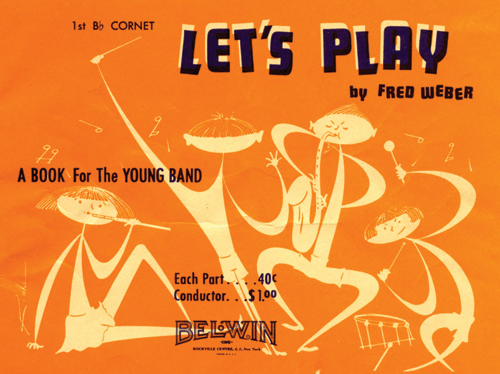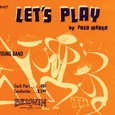
“Easy program music in 2/4, 3/4, 4/4, and 2/2 time.”
The above comment, made about the grade 1 songbook above, is the first review, in its entirety, to appear in The Instrumentalist’s New Music Reviews section. Begun in September 1954 with the aim of “offering readers an opportunity to select music” for their ensembles, in the early years this section was more of a listing of new publications than actual reviews, although a comment or two was included for each piece. It is perhaps a sign of the times that the first anonymous reviewers felt it worthwhile to mention which compositions and arrangements included a full score.
That first installation of reviews included 60 band and orchestra works, with many thousands more to follow, ranging from such heavy hitters as William Schumann’s Chester to comical numbers like Herbert Hazelman’s A Short Ballet for Awkward Dancers. Long-time contributor Charles R. Groeling, who meticulously kept track, reviewed more than 10,000 new works himself, writing in March 2007, “In the years I directed a high school band, such stellar composers as Roger Nixon, Vaclav Nehlybel, Norman Dello Joio, and later Jack Stamp and others emerged. I even enjoy reviewing re-releases of marvelous pieces I first conducted in the 1960s and 1970s. This is like reconnecting with old friends.”
In the spirit of reconnecting with old friends, we sought out the original reviews from some of the works listed in Harry Begian’s 1991 article, “Standards of Excellence for Band Repertoire,” a listing of his recommended grades 3-5 band works. Here are excerpts from reviews of pieces on his list, in hopes that you will find an old favorite to revisit or discover a treasure you never knew existed.
Grade 3
Allerseelen by Richard Strauss, arr. Albert O. Davis (Ludwig). Favorite Strauss art song. First setting for band. Melody surges throughout. Much in style of Wagner. Tranquil beginning and end. April 1955
Toccata for Band by Frank Erickson (Bourne). An unusual piece in that its style is not too closely related to the formal conception of a toccata. . . . There is unique coloring and interesting writing for each instrument. Parts for percussion and low brass are particularly good, and the generally good taste throughout adds musical interest to technical one. May 1957
Fantasia in G Major by J.S. Bach, arr. Goldman and Leist (Mercury). Here is that rare example of Grade V music, both in worth and stature that is completely playable by the Grade III group. The score is always in good taste, and the five part contrapuntal style is a delight to play and to hear. (Begian lists this work as Grade 4.) May 1960
Hebrides Suite by Clare Grundman (Boosey & Hawkes). The scoring is superior with more than average emphasis on the colors of the horns, bass clarinets, bassoons, and saxophones. The result is a British quality of sound both in the score and in the folk-like melodies. April 1963
Liebestod from Tristan and Isolde by Wagner, arr. Glenn C. Bainum (Kjos). For most bands the flow and flexibility have been improved throughout the taking out of needless embellishments. . . . It is all worth the effort, and this would seem to be a lasting contribution to band literature in both the concert and contest sense. (Begian lists this work as Grade 4.) November 1964
Il Re Pastore Overture by W.A. Mozart, arr. Clifford P. Barnes (Ludwig). More musicianship and musical chronology can be taught in one well played performance of a transcription of this kind than in weeks of method books and lecturing…. It should not be shunned by major bands, anymore than it would be overlooked by major symphony orchestras. March 1965
Three Ayres from Gloucester by Hugh M. Stuart (Shawnee). The composer states that the composition came into being through his “fascination with an old 10th century couplet: There’s no one quite so comely/As the Jolly Earl of Cholmonde-ley.” A bit of “Old England” makes this a delightful program piece that most bands can take in stride. January 1970
Blessed Are They by Johannes Brahms, arr. Barbara Buehlman (Ludwig). This arrangement will quickly rank with the dozen or so top works for young band that stress the elements of expressive, rich playing, gratifying musical results, and superior opportunities to learn musicianship through performance. Only because of the long phrases and the frequency of accidentals is this more difficult than Grade II; and it is musically Grade IV.
March 1971
An Irish Rhapsody by Clare Grundman (Boosey & Hawkes). The tunes include “The Moreen (The Minstrel Boy),” “I Know Were I’m Going,” “Shepherd’s Lamb Reel,” “Cockels and Mussels,” “The Rake of Mallow,” and “Kathleen O’More.” The short transitions and modulations are tastefully handled, and the scoring in general will flatter the sounds of even young groups. April 1972
Grade 4
Chorale and Alleluia by Howard Hanson (Carl Fischer). A straight-forward and pleasing non-dissonant modern work. Trumpets have essential part. May 1955
Pageant by Vincent Persichetti (Carl Fischer). Original composition for band. Modern in sound with lively climax. May 1955
Psalm for Band by Vincent Persichetti (Elkan-Vogel). Modern-sounding number for symphonic band. Dramatic ending. Extensive use of separate choirs. May 1955
William Byrd Suite by Gordon Jacob (Boosey & Hawkes). Each [movement] is masterfully scored to flatter the original material and display the color of the modern band at its best. Isolated passages may slightly exceed Grade IV in difficulty, but are balanced by many others that are not harder than Grade III. August 1961
A Festival Prelude by Alfred Reed (Marks). The choirs of brass and woodwinds are used with intimate understanding. The blending of the brass sounds is outstanding. August 1962
Choral Prelude: So Pure the Star by Vincent Persichetti (Elkan-Vogel). This is one of the loveliest things of its kind. It contrasts sharply from the tempo and mood of most of Persichetti’s music. The arrangement is totally fervent in its sincerity, and is beautifully constructed around a chorale melody of breadth and dignity. September 1963
English Dances for Band by Malcolm Arnold, arr. Maurice Johnstone (Mills). There is an undeniable touch of humor in the lighter works of Malcolm Arnold that sets him apart from his colleagues, even those like Gordon Jacob and Benjamin Britten whose musical humor is well known. December 1965
Chorale and Shaker Dance by John Zdechlik (Kjos). This is uncomplicated music with a contemporary originality coupled with elements of traditionalism that make it highly playable and strong in audience appeal. April 1973.
Do Not Go Gentle Into That Good Night by Elliot Del Borgo (Shawnee). It is rare to find music of this length and significance packaged for Grade IV consumption. Other than some difficult arpeggios for bass clarinet and rather high ranges for first trumpet, the only severe challenges to good school bands are duration, changing styles, and unfamiliar (at times) melodic intervals. March 1980
Grade 5
American Overture for Band by Joseph Wilcox Jenkins (Presser). A truly magnificent new overture in a palatable contemporary idiom for the very best symphonic bands. Requires fine skill from every player and superb artistry from the horns. September 1956
Canzona by Peter Mennin (Carl Fischer). Unlike many of his contemporaries, he exploits the instruments for their color and style without extending unreasonably the limits of range and technique. The only phase of the composition that might prove to be a stumbling block to a Grade IV performance is the rhythm, which is always active and stimulating and often complex. September 1958
Incantation and Dance by John Barnes Chance (Boosey & Hawkes). The indication of Grade V should in itself be insufficient to discourage bands from trying this excellent new composition. June 1964
The Solitary Dancer by Warren Benson (MCA). The work is a masterpiece in economy of resources, sensitivity for wind and percussion colors, and subtle development and recession of instrumental and musical frenzy. There are no super demands from the players except for musical style, good listening, and careful precision in ensemble. October 1970
Slava! by Leonard Bernstein, arr. Clare Grundman (Boosey & Hawkes). This overture is filled with vaudevillian razz-ma-tazz complete with glissing trombones, electric guitar, and lighthearted 78 sections. The technical demands are similar to the composer’s Overture to Candide, but the mood is much more slapstick. If you are looking for a number with great audience appeal and you have technically advanced musicians, this would be a terrific choice. April 1979
Beowulf by W. Francis McBeth (Southern). I found the [three] movements appealing and playable. If you are looking for a dramatic compositions with few exposed lines, this may be it. (Begian lists this work as Grade 4.) October 1986
Elegy by Mark Camphouse (T.R.N.) Although long, the work presents a wonderful challenge for soloists, sections, and conductor as it exploits the colors of the modern concert band. If you have the ensemble and soloists, don’t miss this emotional piece. (In the original review, this work was listed as Grade 6.) March 1990





